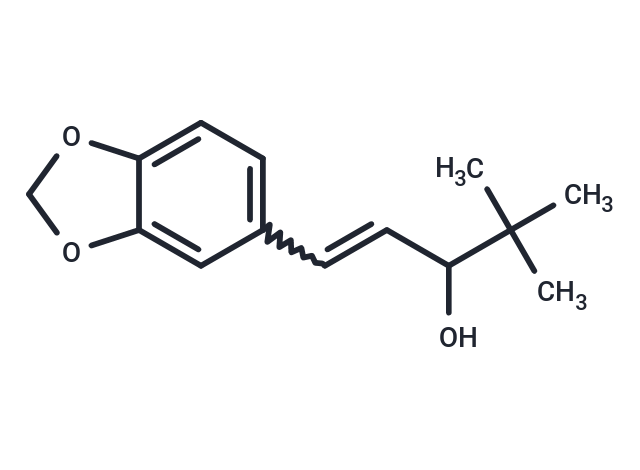Shopping Cart
- Remove All
 Your shopping cart is currently empty
Your shopping cart is currently empty
Stiripentol (BCX2600) (STP) is an anticonvulsant agent, which can inhibit N-demethylation of CLB to NCLB mediated by CYP3A4 (noncompetitively) and CYP2C19 (competitively) with Ki of 1.59/0.516 μM and IC50 of 1.58/3.29 μM, respectively.

| Pack Size | Price | Availability | Quantity |
|---|---|---|---|
| 5 mg | $47 | In Stock | |
| 10 mg | $75 | In Stock | |
| 25 mg | $153 | In Stock | |
| 50 mg | $217 | In Stock | |
| 100 mg | $367 | In Stock | |
| 200 mg | $543 | In Stock | |
| 1 mL x 10 mM (in DMSO) | $50 | In Stock |
| Description | Stiripentol (BCX2600) (STP) is an anticonvulsant agent, which can inhibit N-demethylation of CLB to NCLB mediated by CYP3A4 (noncompetitively) and CYP2C19 (competitively) with Ki of 1.59/0.516 μM and IC50 of 1.58/3.29 μM, respectively. |
| Targets&IC50 | CYP3A4:1.58 μM, CYP2C19:3.29 μM |
| In vitro | The inhibition of CLB demethylation by Stiripentol (STP) is best described by a noncompetitive inhibition model with apparent Ki (1.6 μM) for the cDNA-expressing CYP3A4 and by a competitive inhibition model with Ki (0.52 μM) for the cDNA-expressing CYP2C19. Formation of OH-NCLB from NCLB by cDNA-expressing CYP2C19 is competitively inhibited by Stiripentol (STP) with a Ki: 0.14 μM [1]. |
| In vivo | In mice treated with Stiripentol (STP) monotherapy, the difference between BT1 (39.67±1.09°C) and BT2 (41.32±1.05°C) is statistically significant (t=3.097, p<0.05). The difference in BT2 between Stiripentol (STP) monotherapy and CLB monotherapy is also statistically significant (t=2.615, p<0.05). In mice treated with Stiripentol (STP)+CLB combination therapy, the difference between BT1 (40.18±0.58°C) and BT2 (43.03±0.49°C) is statistically significant (t=10.44, p<0.01) [2]. |
| Cell Research | The inhibition constants (apparent Ki) of Stiripentol (STP) for CLB demethylation by CYP3A4 and CYP2C19 are determined using various concentrations of CLB (2, 10, 20, 40, 60, and 100 μM) with increasing concentrations of Stiripentol (STP) (0, 0.5, 1, 2, and 5 μM). Concerning NCLB hydroxylation by CYP2C19, the apparent Ki is similarly determined with different concentrations of NCLB (1.5, 4, 6, 8, 12, and 14 μM) and STP (0, 0.1, 0.5, 1, and 2 μM). IC50 values are determined by coincubation of the substrate at the concentration in the range of the therapeutic plasma concentrations (2 μM CLB or 14 μM NCLB) with increasing concentrations of Stiripentol (STP) (0.001-10 μM) [1]. |
| Animal Research | Two age groups, p1M (n=18, age 4 weeks) and p5M (n=18, age 5-10 months), of Scn1aRX/+ mice are assigned in this experiment. Both groups are divided randomly into three subgroups (n=6), and each subgroup is administered Stiripentol (STP) (300 mg/kg) alone, CLB (6.62 mg/kg) alone, or a combination of Stiripentol (STP) (p1M; 150 mg/kg, p5M; 300 mg/kg) and CLB (6.62 mg/kg). All drugs are administered by intraperitoneal injection (i.p.) after a 48-h recovery from baseline seizure study. Blood samples are collected at 1 h and 20 min after administration of CLB or STP+CLB for measurement of plasma concentrations of CLB and N-desmethylclobazam, respectively [2]. |
| Synonyms | Diacomit, BCX2600 |
| Molecular Weight | 234.29 |
| Formula | C14H18O3 |
| Cas No. | 49763-96-4 |
| Smiles | C(=CC(C(C)(C)C)O)C=1C=C2C(=CC1)OCO2 |
| Relative Density. | 1.139 g/cm3 (Predicted) |
| Color | White |
| Appearance | Solid |
| Storage | store at low temperature | Powder: -20°C for 3 years | In solvent: -80°C for 1 year | Shipping with blue ice/Shipping at ambient temperature. | |||||||||||||||||||||||||||||||||||
| Solubility Information | DMSO: 250.01 mg/mL (1067.1 mM), Sonication is recommended. Ethanol: 30 mg/mL (128.05 mM), Sonication is recommended. | |||||||||||||||||||||||||||||||||||
Solution Preparation Table | ||||||||||||||||||||||||||||||||||||
Ethanol/DMSO
| ||||||||||||||||||||||||||||||||||||

Copyright © 2015-2025 TargetMol Chemicals Inc. All Rights Reserved.